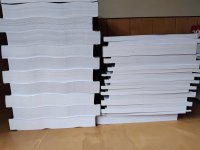I am starting a small publishing venture, on a low budget, in a remote and isolated part of the world (New Zealand). This means I am limited to whatever is available locally and fits into my small budget.
I started off with an Epson EcoTank ET-16600, but the speed is too slow to be efficient, the duty cycle is a constant worry and the quality not too great (if you look closely).
Then I went for a Kyocera EcoSys p3155dn, which has a better speed, duty cycle and quality, but.. the paper comes out all wavy. I have spent days googling it, but 99% of the "solutions" out there are either not applicable or affordable. I have tested 6 different paper suppliers, some of them of a reputable quality, same problem. I have used paper from sealed packets, my environment is not excessively humid or dry or hot or cold, I have fanned the paper, turned it over, used the rear exit for a straighter path, printed single sided twice, changed the media settings, etc.. same problem.
I am also checking with Kyocera to see whether perhaps I have a dud printer with a fuser temperature that is too high. So far all I got was "this is within specs". Within specs? See the attached image!
I have read a few threads on this forum, one was especially interesting, about a printer from Israel who had the same problem and found the solution was to let the wavy books sit for two weeks and they would straighten out again. I have tried that, but no luck. It seems to me that the paper has been permanently deformed.
I now have three questions:
1. Is there any way I can solve this problem with my current laser printer?
2. What would be a way forward, considering my limited access to, and affordability of the latest and bestest technology?
3. How have other businesses managed to climb the ladder, from starting off on a shoestring to being able to afford the big toys? Can it be done without getting into debt or winning the lotto?
PS: The text blocks on the left were printer with the laser printer, the ones on the right with the inkjet printer.
I started off with an Epson EcoTank ET-16600, but the speed is too slow to be efficient, the duty cycle is a constant worry and the quality not too great (if you look closely).
Then I went for a Kyocera EcoSys p3155dn, which has a better speed, duty cycle and quality, but.. the paper comes out all wavy. I have spent days googling it, but 99% of the "solutions" out there are either not applicable or affordable. I have tested 6 different paper suppliers, some of them of a reputable quality, same problem. I have used paper from sealed packets, my environment is not excessively humid or dry or hot or cold, I have fanned the paper, turned it over, used the rear exit for a straighter path, printed single sided twice, changed the media settings, etc.. same problem.
I am also checking with Kyocera to see whether perhaps I have a dud printer with a fuser temperature that is too high. So far all I got was "this is within specs". Within specs? See the attached image!
I have read a few threads on this forum, one was especially interesting, about a printer from Israel who had the same problem and found the solution was to let the wavy books sit for two weeks and they would straighten out again. I have tried that, but no luck. It seems to me that the paper has been permanently deformed.
I now have three questions:
1. Is there any way I can solve this problem with my current laser printer?
2. What would be a way forward, considering my limited access to, and affordability of the latest and bestest technology?
3. How have other businesses managed to climb the ladder, from starting off on a shoestring to being able to afford the big toys? Can it be done without getting into debt or winning the lotto?
PS: The text blocks on the left were printer with the laser printer, the ones on the right with the inkjet printer.














